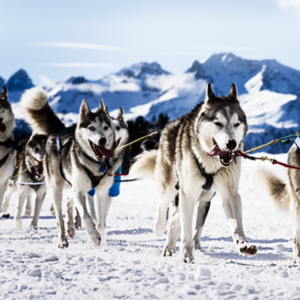
A report in the June 2, 2017 edition of Science magazine digs into findings from an ancient archaeological site on the very remote and very, very cold Zhokhov Island, to show that the locals, hardy human hunters, not only lived and worked with dogs, but also quite probably selectively bred the dogs for certain traits.
Archaeologist Vladmir Pitulko with the Russian Academy of Sciences has been excavating on Zhokhov Island since 1989, where he has found dog bones as well as remnants of wooden sleds. With archaezoologist Aleksey Kasparov, also of the RAS, they’ve compared two of the most complete dog skulls found to those of contemporary Siberian Huskies and wolves.
Pitulko and Kasparov wanted to first determine if the skulls were those of dogs or wolves. They first employed two key skull ratios: snout height to skull length and cranium height to skull length. Using these ratios, they were able to reliably distinguish between skulls of a modern wolf and husky.
By applying these ratios to the ancient skulls, they determined that one skull was that of a dog, while the other was probably a wolf-dog hybrid.
In order to determine the approximate size of the Zhokhov dogs, they used bones from 11 fossilized individuals and extrapolated to determine that 10 of the individuals weighed between 16 and 25 kilograms (35–55lbs). The eleventh dog, believed to be a wolf-dog hybrid weighed almost 29kg (about 64lbs). Pitulko and Kasparov estimate that the ten smaller dogs resembled Siberian Huskies in size, while the larger specimen is thought to be similar in size to an Alaskan Malamute.

Details of this research will be published next month in the Journal of Archaeological Science: Reports .
Pitulko postulates that the variety of dog sizes show evidence of selective breeding, with the smaller-sized dogs possibly developed for pulling sleds, while the larger dogs would have been valuable for hunting polar bears. He noted that contemporary sled dog racers find that slightly smaller dogs are better able to regulate body temperature than larger dogs.
A National Geographic article, What Makes a Great Sled Dog? agrees, noting that the larger Alaskan Malamutes have fallen out of favor with modern sled dog racers, in part because they are not fast enough.
Angela Perri, a zooarchaelogist at the Max Planck Institute for Evolutionary Anthropology in Leipzig, Germany notes that this work helps to fill in “a missing piece of the puzzle of early human-dog relationships, and even domestication itself”. Before this finding, the next earliest evidence of dog breeding is in the Near East where herding dogs are believed to have been bred 7,000 years ago.
The Backstory
Zhokhovians, besides potentially the first to selectively breed dogs, were a very hardy people. They not only survived year-round on an island north of Russia in tents constructed of hide, but also are the only known humans to hunt polar bears without the use of firearms.
Zhokhovians also hunted caribou, and to accomplish this, needed a means of covering many kilometers in the chase and return home. We know today that wolves, hunting in packs are capable of taking down elk; perhaps the dogs both pulled the sleds and caught the caribou.
Beyond the evidence of earliest dog breeding and selecting for size and work ability, this is fascinating evidence of domestication, as A. Perri noted. The Zhokhovians were working side-by-side with the dogs to hunt their food, and gather skins (from bears, caribou and smaller mammals) for their tents, and presumably clothing.
Under such frigid living conditions, one might add one other use for dogs: warm sleeping companions.
Here is David Grimm’s article from Science:
Grimm, D. (2017) Siberia yields earliest evidence for dog breeding. Science 356, 896.
DOI: https://doi.org/10.1126/science.356.6341.896
PubMed: 28572346
